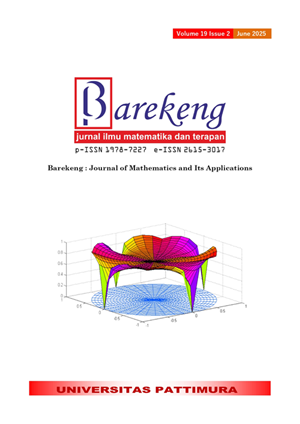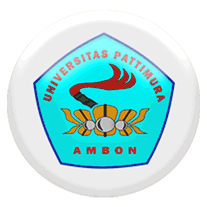GRAPHICAL REPRESENTATION AND TWO GROUPS ANALYSIS ON DATA MATRIX OF ROBUSTA GREEN CHERRIES PRODUCTION IN TWO HARVEST PERIODS
Abstract
Several factors that play a role in the productivity of Robusta coffee trees are the influence of pruning techniques and weather elements. This paper discussed the graphical analysis and comparison of two data matrices of Robusta green cherries production, which would enter the ripening process in branch categories for the harvest period in 2023 and 2024. Hypothesis testing on secondary data in the form of daily weather conditions in 2022 and 2023, which include temperature, dew, humidity, wind speed, and cloud cover for the two periods, was significantly different. However, solar radiation and precipitation were not. The data source for each harvest period was primary data, with the object being a sample of 30 trees that were sampled purposively. The research object was in Pagaralam Municipality, South Sumatra. There were 18 variables covering many branch categories based on production year, position, and shape. The PCA (Principal Component Analysis) results on each data matrix show similarities in the dominant variables representing each subspace. The first three PCs in each data matrix for 2023 and 2024 span a subspace and describe the variation of the original data of 77.3% and 68.8%, respectively. The 3rd and 1st-year production branch categories dominate the subspace of each data matrix for 2023 and 2024. Comparison of the two PC subspaces using two groups analysis in 3rd dimension space produces angles of 19.70, 28.80, and 69.10. The bisector components show that the variables that dominate the similarity of the two data matrices are the variables that tend to represent both PC subspaces dominantly. Robusta green cherry production can be represented by the number of secondary branches, which are straight in shape, along with the number of fruit clusters. This study result can be a reference for farmers when considering the composition of the number of branch categories when pruning.
Downloads
References
J. Kath, V. Mittahalli, Byrareddy, S. Mushtaq, A. Craparo, and P. Mario, “TEMPERATURE AND RAINFALL IMPACTS ON ROBUSTA COFFEE BEAN CHARACTERISTICS,” Clim. Risk Manag., vol. 32, no. 100281, pp. 1–15, January 2021.
T. R. Moreira, S. F. da Silva, N. B. da Silva, G. M. A. D. A. dos Santos, and A. R. dos Santos, “GLOBAL WARMING AND THE EFFECTS OF CLIMATE CHANGE ON COFFEE PRODUCTION,” Food Engineering Series: Quality Determinants In Coffee Production, 1st ed. Switzerland: Springer Cham, 2021, 65–100.
E. Rahn, P. Vaastd, P. Läderachb, P. van Astenc, L. Jassognec, and J. Ghazoul, “EXPLORING ADAPTATION STRATEGIES OF COFFEE PRODUCTION TO CLIMATE CHANGE USING A PROCESS-BASED MODEL,” Ecol. Modell., vol. 371, pp. 76–89, January 2018.
N. Van Long, N. Q. Ngoc, N. N. Dung, P. Kristiansen, I. Yunusa, and C. Fyfe, “THE EFFECTS OF SHADE TREE TYPES ON LIGHT VARIATION AND ROBUSTA COFFEE PRODUCTION IN VIETNAM,” Engineering, vol. 7, pp. 742–753, November 2015.
N. Khayati, A. Wachjar, and Sudarsono, “PENGELOLAAN PEMANGKASAN TANAMAN KOPI ARABIKA (COFFEA ARABICA L.) DI KEBUN KALISAT JAMPIT, PT PERKEBUNAN NUSANTARA XII (PERSERO), BONDOWOSO, JAWA TIMUR,” Bul. Agrohorti, vol. 7, no. 3, pp. 295–301, May 2019.
E. Mustari, “PERBEDAAN...MEMBUKA PELUANG UNTUK PENGEMBANGAN KOPI LEBIH BERMANFAAT,” Webinar Pengurus Perkumpulan Enterprener Ganesha, STIH ITB, 2021.
S. Tahmrin, J. Ashan, Muh Dzulkifly Junaedi, M. N. I. Ilham, and M. Maslam, “PENERAPAN TEKNOLOGI BUDIDAYA TANAMAN KOPI SECARA BERKELANJUTAN BAGI PETANI DI KABUPATEN GOWA,” J. Apl. Teknol. Rekayasa dan Inov., vol. 2, no. 1, pp. 34–41, April 2023.
Z. Zulkarnain, Rahmaddiansyah, R. Alpian, and B. Bagio, “TINGKAT PRODUKTIVITAS DAN PENDAPATAN PETANI KOPI ARABIKA YANG MELAKUKAN TEKNIK PEMANGKASAN RUTIN DAN YANG TIDAK DI KECAMATAN BENER KELIPAH,” Agrifo, vol. 5, no. 1, pp. 78–86, June 2020.
R. Subantoro and M. A. Azis, “TEKNIK PEMANGKASAN TANAMAN KOPI (COFFEA sp),” MEDIAGRO, vol. 15, no. 1, pp. 52–65, November 2019.
IDH (The Sustainable Trade Initiative), SCP (The Sustainable Coffee Program), and TechnoServe, “A BUSINESS CASE FOR SUSTAINABLE COFFEE PRODUCTION,” IDH, 2014. [Online]. Available: http://exchange.growasia.org/indonesia-business-case-sustainable-coffee-production [Accessed on November 2, 2023].
C. Bilen, D. El Chami, V. Mereu, A. Trabucco, S. Marras, and D. Spano, “A SYSTEMATIC REVIEW ON THE IMPACTS OF CLIMATE CHANGE ON COFFEE AGROSYSTEMS,” Plants, vol. 12, no. 102, pp. 1–20, June 2023.
S. G. Mbwambo, S. K. Mourice, and A. J. P. Tarimo, “THE IMPACTS OF CURRENT CLIMATE VARIABILITY ON COFFEE PRODUCTION IN THE NORTHERN AND SOUTHERN HIGHLANDS OF TANZANIA,” J. Agric. Sci., vol. 14, no. 3, pp. 78–99, February 2022.
T. L. A. Dinh, F. Aires, and E. Rahn, “STATISTICAL ANALYSIS OF THE WEATHER IMPACT ON ROBUSTA COFFEE YIELD IN VIETNAM,” Front. Environ. Sci., vol. 10, no. 820916, pp. 1–15, June 2022.
A. W. Angka and S. Dewi, “DAMPAK PERUBAHAN IKLIM TERHADAP PRODUKTIVITAS KOPI ROBUSTA DI DESA KURRAK KECAMATAN TAPANGO KABUPATEN POLEWALI MANDAR,” Media Agribisnis, vol. 5, no. 2, pp. 133–139, November 2021.
F. H. Assamha and R. Boer, “DAMPAK PERUBAHAN IKLIM TERHADAP PRODUKTIVITAS TANAMAN KOPI DI KABUPATEN TANA TORAJA,” Thesis, IPB University, Bogor, Indonesia, 2017.
D. P. Widiyani and J. S. S. Hartono, “STUDI EKSPLORASI AGROKLIMAT TANAMAN KOPI ROBUSTA (COFFEA CANEPHORA) KABUPATEN TANGGAMUS, LAMPUNG,” J. Agroteknologi dan Agribisnis, vol. 5, no. 1, pp. 20–29, March 2021.
BPS-Statistics Indonesia, STATISTICAL YEARBOOK OF INDONESIA 2024. Jakarta: BPS-Statistics Indonesia, 2024.
Directorate of Food Crops, Horticulture, and Estate Crops Statistics, INDONESIAN COFFEE STATISTICS 2023. Jakarta: BPS-Statistics Indonesia, 2024.
Irmeilyana, Ngudiantoro, S. I. Maiyanti, and S. Makhalli, “LOGISTIC REGRESSION MODELING OF THE USE OF REDUCTANT HERBICIDE IN PAGARALAM COFFEE FARMING,” Barekeng, vol. 17, no. 4, pp. 1957–1968, December 2023.
I. T. Jolliffe, PRINCIPAL COMPONENT ANALYSIS, 2nd ed. New York: Springer Verlag, 2002.
W. J. Krzanowski, PRINCIPLE OF MULTIVARIATE ANALYSIS, A USER’S PERSPECTIVE. New York: Oxford University Press, 1990.
Irmeilyana, Ngudiantoro, and S. I. Maiyanti, “APPLICATION OF TWO GROUPS ANALYSIS AND CLUSTER ANALYSIS ON COMPARISON OF CHARACTERISTICS OF PAGARALAM COFFEE FARMERS CATEGORIES,” Barekeng, vol. 17, no. 1, pp. 101–112, March 2023.
P. Postiglione, A. Artone, M. S. Andreano, and R. Benedetti, “CONSTRAINED OPTIMIZATION FOR ADDRESSING SPATIAL HETEROGENEITY IN PRINCIPAL COMPONENT ANALYSIS: AN APPLICATION TO COMPOSITE INDICATORS,” Stat. Methods Appt., vol. 32, pp. 1539–1561, May 2023.
B. Bezděková, F. Němec, and J. Manninen, “GROUND-BASED VLF WAVE INTENSITY VARIATIONS INVESTIGATED BY THE PRINCIPAL COMPONENT ANALYSIS,” Earth, Planets Sp., vol. 74, no. 30, pp. 1–15, February 2022.
P. Tóth, B. L. Tarcsay, Z. Kovács, D. T. Ionescu, S. Németh, and · Endre Domokos, “ASSESSMENT OF THE CORRELATION BETWEEN THE NUTRIENT LOAD FROM MIGRATORY BIRD EXCREMENT AND WATER QUALITY BY PRINCIPAL COMPONENT ANALYSIS IN A FRESHWATER HABITAT,” Environ. Sci. Pollut. Res., vol. 30, pp. 66033–66049, April 2023.
P. J. Ramos, F. A. Prieto, E. C. Montoya, and C. E. Oliveros, “AUTOMATIC FRUIT COUNT ON COFFEE BRANCHES USING COMPUTER VISION,” Computers and Electronics in Agriculture, vol. 137, pp. 9–22, May 2017.
P. J. Ramos, J. Avendaño, and F. A. Prieto, “MEASUREMENT OF THE RIPENING RATE ON COFFEE BRANCHES BY USING 3D IMAGES IN OUTDOOR ENVIRONMENTS,” Computers in Industry, vol. 99, pp. 83–95, August 2018.
J. P. Rodríguez, D. C. Corrales, J. N. Aubertot, and J. C. Corrales, “A COMPUTER VISION SYSTEM FOR AUTOMATIC CHERRY BEANS DETECTION ON COFFEE TREES,” Pattern Recognition Letters, vol. 136, pp. 142–153, August 2020.
J. P. R. Uez, D. C. Corrales, D. Griol, Z. Callejas, Corrales, and J. Carlos, “A NON-DESTRUCTIVE TIME SERIES MODEL FOR THE ESTIMATION OF CHERRY COFFEE PRODUCTION,” Computers, Materials & Continua, vol. 70, no. 3, pp. 4725–4743, January 2022.
B. Haryanto, A. Thohar, H. Basri, D. Widodo, N. S. Wibowo, and J. Juniawan, KURIKULUM NASIONAL DAN MODUL PELATIHAN BUDIDAYA BERKELANJUTAN (GOOD AGRICULTURAL PRACTICES-GAP) DAN PASCAPANEN (POST-HARVEST) KOPI ROBUSTA. Jakarta: BPP SDM Pertanian, Kementerian Pertanian RI, 2019.
N. Trendafilov and M. Gallo, “PRINCIPAL COMPONENT ANALYSIS (PCA),” MULTIVARIATE DATA ANALYSIS ON MATRIX MANIFOLDS (WITH MANOPT). Switzerland: Springer Cham, 2021, 89-139.
Copyright (c) 2025 Irmeilyana Irmeilyana, Bambang Suprihatin, Anita Desiani, Ngudiantoro Ngudiantoro, Sri Indra Maiyanti

This work is licensed under a Creative Commons Attribution-ShareAlike 4.0 International License.
Authors who publish with this Journal agree to the following terms:
- Author retain copyright and grant the journal right of first publication with the work simultaneously licensed under a creative commons attribution license that allow others to share the work within an acknowledgement of the work’s authorship and initial publication of this journal.
- Authors are able to enter into separate, additional contractual arrangement for the non-exclusive distribution of the journal’s published version of the work (e.g. acknowledgement of its initial publication in this journal).
- Authors are permitted and encouraged to post their work online (e.g. in institutional repositories or on their websites) prior to and during the submission process, as it can lead to productive exchanges, as well as earlier and greater citation of published works.






1.gif)



